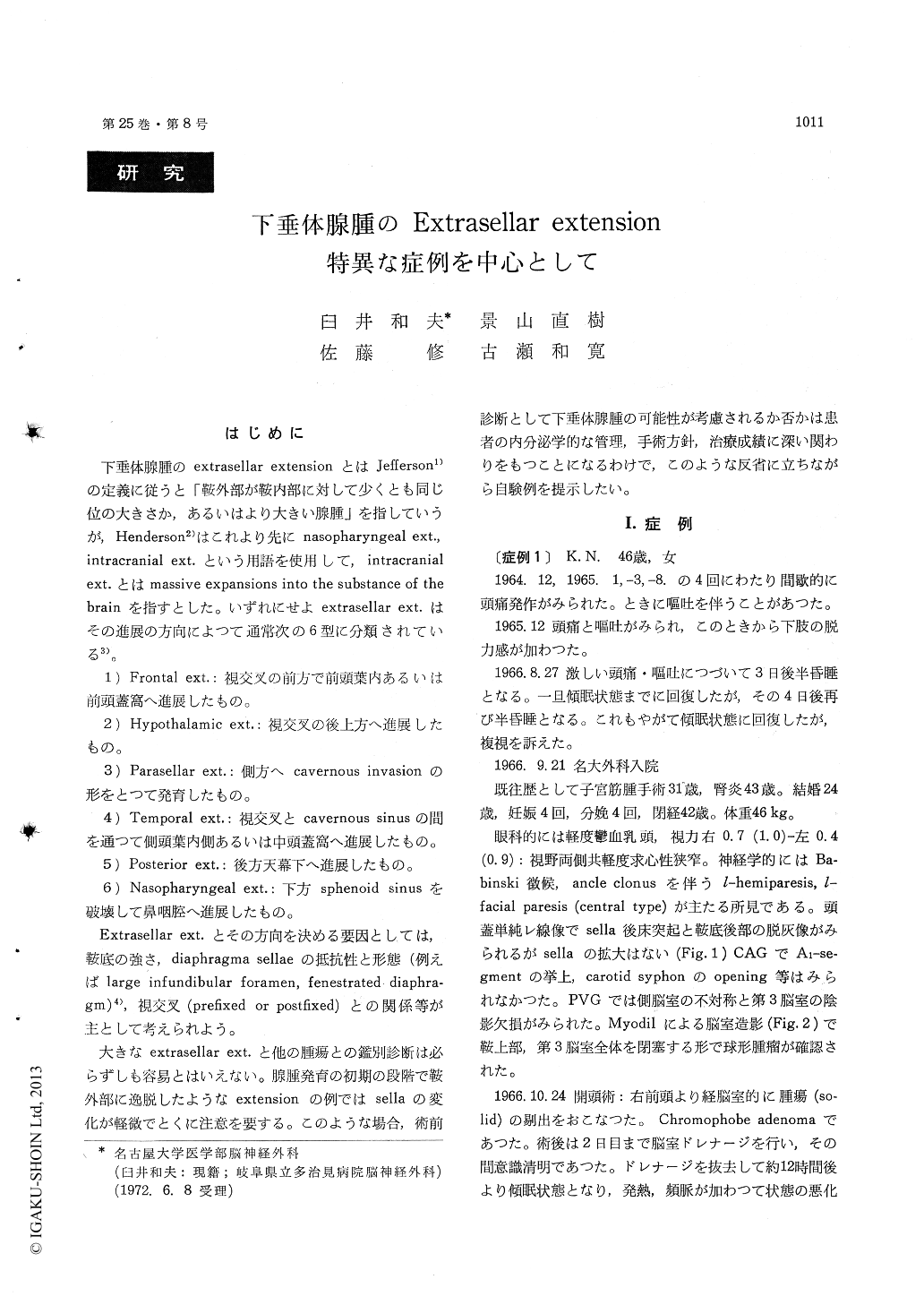Japanese
English
- 有料閲覧
- Abstract 文献概要
- 1ページ目 Look Inside
はじめに
下垂体腺腫のextrasellar extensionとはJefferson1)の定義に従うと「鞍外部が鞍内部に対して少くとも同じ位の大きさか,あるいはより大きい腺腫」を指していうが,Henderson2)はこれより先にnasopharyngeal ext., intracranial ext.という用語を使用して,intracranialext.とはmassive expansions into the substance of thebrainを指すとした。いずれにせよextrasellar ext.はその進展の方向によって通常次の6型に分類されている3)。
1) Frontal ext.:視交叉の前方で前頭葉内あるいは前頭蓋窩へ進展したもの。
The authors have presented 4 cases of chro-mophobe adenoma with unusually large extrasellar extensions.
Case 1: hypothalamic extension.
Radiologically, destruction of the sella was min-imal and elevation of Ai-segment of the a. c. a was not found, nor the opening of carotid syphon. Suprasellar mass was first visualized by Myodil ventriculography. Transventricular removal of the adenoma resulted in extensive hypothalamic lesion. Preoperative diagnosis was more likely colloid cyst or craniopharyngioma than pituitary adenoma.
Case 2: posterior (subtentorial) extension.
The patient was characterized by intermittent disturbances of consciousness. On VAG, posteriordeviation of the basilar artery was noticed. Preo-perative diagnosis was chordoma or clivus menin-gioma. Subtemporal, subtentorial removal of the adenoma was undertaken. Autopsy revealed a large adenoma which extended above into the hypo-thalamus, posteriorly into the prepontine cistern, and anteriorly into the right superior orbital fissure.
Case 3 : temporal extension (cavernous invasion).
The patient was characterized by cavernous syn-drome. Carotid angiograms showed elevation of carotid bifurcation and strong anterior-downward streching of cavernous and precavernous portions of the internal carotid artery. Mild ballooning of the sella was noticed. Subtemporal craniotomy revealed a large epidual extension of the adenoma. The patient became diabetic during the period of postoperative irradiation therapy.
Case 4: frontal extension.
A very large extension into the anterior cranial fossa and between the frontal lobes was visualized on CAG and PEG. The sella was strongly de-structed and enlarged in this case, and preoperative diagnosis was necessarily difficult. However, CAG and PEG showed the similar pictures of craniopharyngioma or olfactory groove meningioma. The cyst was evacuated and this was followed by frontal lobectomy and removal of the capsule.
Conclusions : Exact preoperative diagnosis is most important in cases of pituitary adenoma. Large extrasellar extensions of the adenoma are often difficult to diagnose, because their clinical and radiological findings are apt to be atypical. Any minimal changes of the sella must be looked for. Endocrinological examinations are indispensable in cases of parasellar mass.

Copyright © 1973, Igaku-Shoin Ltd. All rights reserved.


